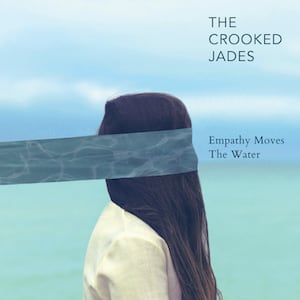 The Crooked Jades – Empathy Moves The Water
The Crooked Jades – Empathy Moves The Water
Jade Note Music – 11 March 2019
The California-based Crooked Jades have long been regarded as one of the most innovative of the latter-day old-time-rooted string bands. Since their debut in 1996, they’ve released eight albums, and Empathy Moves The Water, their ninth, comes after a way-too-long gap. It’s been a whole decade since the last proper studio album released under the Crooked Jades banner (Shining Darkness) – which had only founder member Jeff Kazor in common with the current lineup – with only the soundtrack album for documentary movie Bright Land (2012) appearing since then in the interim.
The new album has been financially sponsored by an unnamed fan who, the story goes, was particularly impressed with the band’s performance at the California Bluegrass Association Father’s Day Bluegrass Festival a couple of years back. It features the now-fairly-long-standing Crooked Jades lineup comprising main man Jeff Kazor (guitar, harmonium) with cohorts Lisa Berman (slide guitar), Erik Pearson (minstrel banjo and slide guitar), Megan Adie (bass and arco bass) and Emily Mann (fiddle). At the helm, this time is the widely-respected producer and multi-instrumentalist Bruce Kaphan, who clearly has the measure of the Crooked Jades mission.
Empathy Moves The Water turns out to be a highly appropriate title for this collection of songs and instrumental pieces (proportioned roughly half-and-half) that purport to emphasise the “lonesome” in “high lonesome” music. The band’s special trademark has always been a soulful modern re-creation of the sensibility of old-time roots music (albeit at times it has been said closer in spirit to Tom Waits and Nick Cave), “reflecting the cultural melange and longing implicit in the shadows of America”. It’s easy to clock what this means as you take in the delights of this album, which migrates from energetic revival songs inspired by early rural gospel blues to haunting fiddle-drenched ballads expressing the isolation and humanity lost in a rapidly changing land. The band is noted for its signature mix of inspired rearrangements of obscure old-time gems and Jeff’s special original compositions, and its unique sound derives from the eclectic choice of vintage instruments deployed, like Hawaiian slide, harmonium and minstrel banjo.
Opening cut Ryland And Spencer (Rise And Bloom Again) and the ensuing instrumental Featherbed take the high-energy road, ensuring the listener is engaged and tagging along nicely. Then, Down To The River is the first of the lonesome ballads, where you can hear Lisa a-lamentin’ as she’s standing by the lapping waters; this song’s listed as being inspired by Fred McDowell, and it certainly possesses that characteristic loping rhythmic lilt as its argument ebbs and flows. The enigmatically titled Yellow Mercury 4 follows, a plaintive Kazor-penned instrumental piece led by Bruce’s pedal steel and Megan’s swooning arco bass. Going To The Sea brings the subliminal water sounds in again as an undertow for the drone introducing Erik’s yearning song of departure, which around halfway in steps up the tempo into a banjo-led ensemble breakdown. The Water Spirit According To Mike is little more than an interlude betwixt the ballads, an ephemeral, swift-rushing fife-and-fiddle tune that gets out of the way fast.
The album’s title song is a standout track. This Jeff Kazor composition eerily invokes the stripping-away of humanity, initially with its signature “we are not human… we are not men, we are?” mantra that connects the evacuation of peoples with the isolation imposed by the digital age (and echoes of both Jim Morrison and Devo too perhaps?), and later with its clattering handclapping chant of uncertain togetherness, running along on shifting sands to a primitive half-defined dance rhythm. Mike In The Wilderness is a back-to-basics uptempo traditional fiddle-tune instrumental that resonates all the more for its placing after the preceding tableau.
Then comes a powerful little sequence taking an unusual slant on traditional sources; opening with an ambient a cappella take on Long Time Traveling in mournful three-part female harmony, this then leads via what sounds like a tambura drone into a slightly weird, rockily-driven full-ensemble Wade In The Water that, while duly empathy-laden, interweaves some disturbing whispered vocalisations and other effects amidst the principal vocal lines and forward-charging instrumentation. This subsides into a rich drone-based instrumental (fiddle, harmonium, arco bass) rendition of Am I Born To Die?, which is (I think) implied as intentionally conflating with the melody of Long Time Traveling. Full marks to the band for their enterprise on this section of the album, which leaves quite an impression. It’s also quite an act to follow, but an unusual two-part instrumental take on old favourite Pretty Little Shoes fills the bill nicely, and builds into something of a foot-tapper before making way for album finale Yellow Mercury 3, which reveals itself as to all intents and purposes a vocal counterpart of the instrumental Yellow Mercury 4 of half-an-hour earlier. With plangent pedal steel, dobro, Weissenborn and massed fiddle it drips with the ambience of Burritos/American-Beauty-era Grateful Dead, and makes for the epitome of lonesome as a lasting groove and a satisfying conclusion to the whole project. Its compelling sounds and spirit are destined to haunt you still.
I must also give mention to the handsome presentation of the album – it’s encased in a beautiful and eco-friendly six-panel digipack complete with booklet, all designed by veteran album cover designer Bob Ciano.
Yeah, it’s been far too long away, Crooked Jades – we’ve sure missed you, and please don’t make it so long before your next album.

